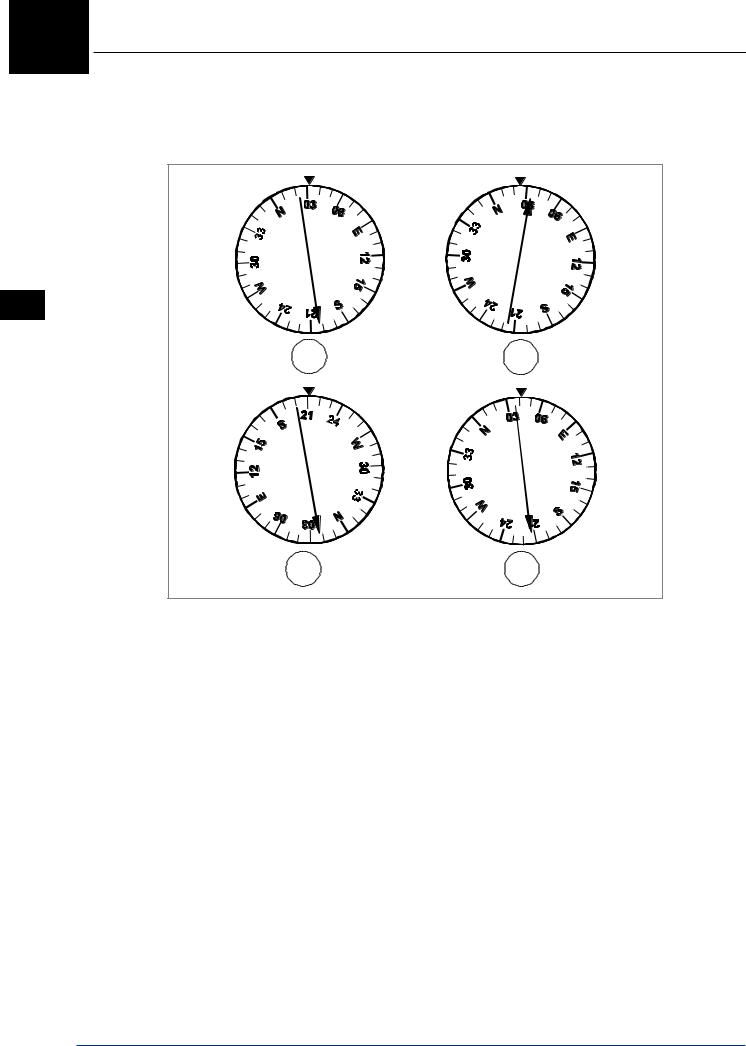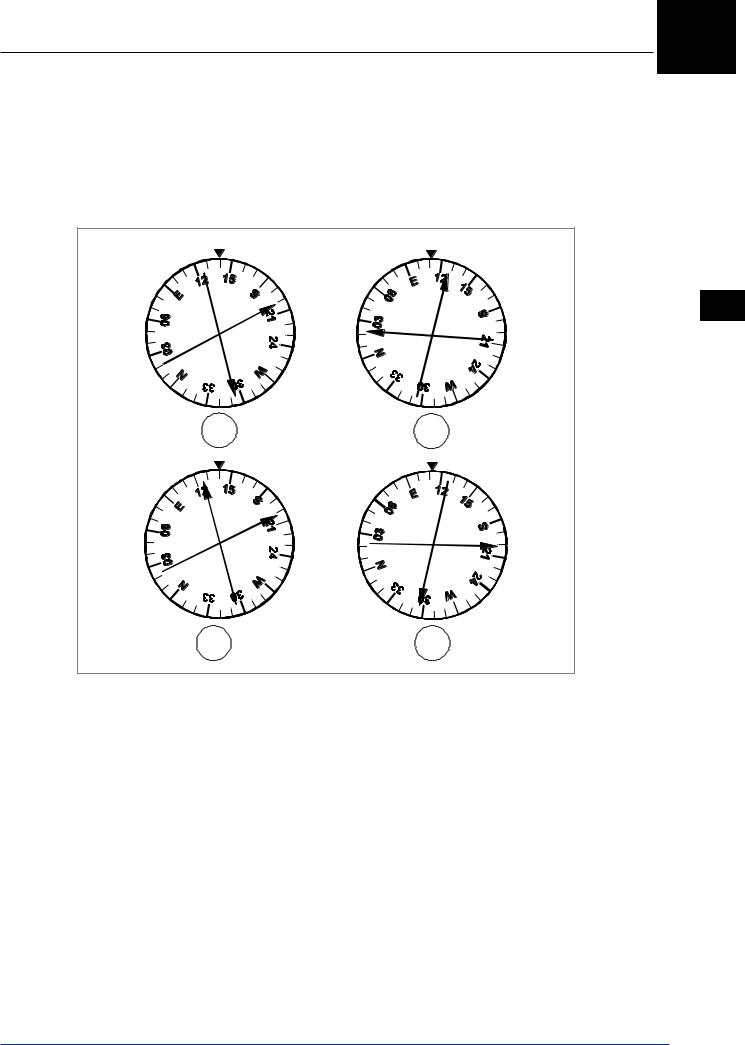
- •Textbook Series
- •Contents
- •1 Properties of Radio Waves
- •Introduction
- •The Radio Navigation Syllabus
- •Electromagnetic (EM) Radiation
- •Polarization
- •Radio Waves
- •Wavelength
- •Frequency Bands
- •Phase Comparison
- •Practice Frequency (
- •Answers to Practice Frequency (
- •Questions
- •Answers
- •2 Radio Propagation Theory
- •Introduction
- •Factors Affecting Propagation
- •Propagation Paths
- •Non-ionospheric Propagation
- •Ionospheric Propagation
- •Sky Wave
- •HF Communications
- •Propagation Summary
- •Super-refraction
- •Sub-refraction
- •Questions
- •Answers
- •3 Modulation
- •Introduction
- •Keyed Modulation
- •Amplitude Modulation (AM)
- •Single Sideband (SSB)
- •Frequency Modulation (FM)
- •Phase Modulation
- •Pulse Modulation
- •Emission Designators
- •Questions
- •Answers
- •4 Antennae
- •Introduction
- •Basic Principles
- •Aerial Feeders
- •Polar Diagrams
- •Directivity
- •Radar Aerials
- •Modern Radar Antennae
- •Questions
- •Answers
- •5 Doppler Radar Systems
- •Introduction
- •The Doppler Principle
- •Airborne Doppler
- •Janus Array System
- •Doppler Operation
- •Doppler Navigation Systems
- •Questions
- •Answers
- •6 VHF Direction Finder (VDF)
- •Introduction
- •Procedures
- •Principle of Operation
- •Range of VDF
- •Factors Affecting Accuracy
- •Determination of Position
- •VDF Summary
- •Questions
- •Answers
- •7 Automatic Direction Finder (ADF)
- •Introduction
- •Non-directional Beacon (NDB)
- •Principle of Operation
- •Frequencies and Types of NDB
- •Aircraft Equipment
- •Emission Characteristics and Beat Frequency Oscillator (BFO)
- •Presentation of Information
- •Uses of the Non-directional Beacon
- •Plotting ADF Bearings
- •Track Maintenance Using the RBI
- •Homing
- •Tracking Inbound
- •Tracking Outbound
- •Drift Assessment and Regaining Inbound Track
- •Drift Assessment and Outbound Track Maintenance
- •Holding
- •Runway Instrument Approach Procedures
- •Factors Affecting ADF Accuracy
- •Factors Affecting ADF Range
- •Accuracy
- •ADF Summary
- •Questions
- •Answers
- •8 VHF Omni-directional Range (VOR)
- •Introduction
- •The Principle of Operation
- •Terminology
- •Transmission Details
- •Identification
- •Monitoring
- •Types of VOR
- •The Factors Affecting Operational Range of VOR
- •Factors Affecting VOR Beacon Accuracy
- •The Cone of Ambiguity
- •Doppler VOR (DVOR)
- •VOR Airborne Equipment
- •VOR Deviation Indicator
- •Radio Magnetic Indicator (RMI)
- •Questions
- •In-flight Procedures
- •VOR Summary
- •Questions
- •Annex A
- •Annex B
- •Annex C
- •Answers
- •Answers to Page 128
- •9 Instrument Landing System (ILS)
- •Introduction
- •ILS Components
- •ILS Frequencies
- •DME Paired with ILS Channels
- •ILS Identification
- •Marker Beacons
- •Ground Monitoring of ILS Transmissions
- •ILS Coverage
- •ILS Principle of Operation
- •ILS Presentation and Interpretation
- •ILS Categories (ICAO)
- •Errors and Accuracy
- •Factors Affecting Range and Accuracy
- •ILS Approach Chart
- •ILS Calculations
- •ILS Summary
- •Questions
- •Answers
- •10 Microwave Landing System (MLS)
- •Introduction
- •ILS Disadvantages
- •The MLS System
- •Principle of Operation
- •Airborne Equipment
- •Question
- •Answer
- •11 Radar Principles
- •Introduction
- •Types of Pulsed Radars
- •Radar Applications
- •Radar Frequencies
- •Pulse Technique
- •Theoretical Maximum Range
- •Primary Radars
- •The Range of Primary Radar
- •Radar Measurements
- •Radar Resolution
- •Moving Target Indication (MTI)
- •Radar Antennae
- •Questions
- •Answers
- •12 Ground Radar
- •Introduction
- •Area Surveillance Radars (ASR)
- •Terminal Surveillance Area Radars
- •Aerodrome Surveillance Approach Radars
- •Airport Surface Movement Radar (ASMR)
- •Questions
- •Answers
- •13 Airborne Weather Radar
- •Introduction
- •Component Parts
- •AWR Functions
- •Principle of Operation
- •Weather Depiction
- •Control Unit
- •Function Switch
- •Mapping Operation
- •Pre-flight Checks
- •Weather Operation
- •Colour AWR Controls
- •AWR Summary
- •Questions
- •Answers
- •14 Secondary Surveillance Radar (SSR)
- •Introduction
- •Advantages of SSR
- •SSR Display
- •SSR Frequencies and Transmissions
- •Modes
- •Mode C
- •SSR Operating Procedure
- •Special Codes
- •Disadvantages of SSR
- •Mode S
- •Pulses
- •Benefits of Mode S
- •Communication Protocols
- •Levels of Mode S Transponders
- •Downlink Aircraft Parameters (DAPS)
- •Future Expansion of Mode S Surveillance Services
- •SSR Summary
- •Questions
- •Answers
- •15 Distance Measuring Equipment (DME)
- •Introduction
- •Frequencies
- •Uses of DME
- •Principle of Operation
- •Twin Pulses
- •Range Search
- •Beacon Saturation
- •Station Identification
- •VOR/DME Frequency Pairing
- •DME Range Measurement for ILS
- •Range and Coverage
- •Accuracy
- •DME Summary
- •Questions
- •Answers
- •16 Area Navigation Systems (RNAV)
- •Introduction
- •Benefits of RNAV
- •Types and Levels of RNAV
- •A Simple 2D RNAV System
- •Operation of a Simple 2D RNAV System
- •Principle of Operation of a Simple 2D RNAV System
- •Limitations and Accuracy of Simple RNAV Systems
- •Level 4 RNAV Systems
- •Requirements for a 4D RNAV System
- •Control and Display Unit (CDU)
- •Climb
- •Cruise
- •Descent
- •Kalman Filtering
- •Questions
- •Appendix A
- •Answers
- •17 Electronic Flight Information System (EFIS)
- •Introduction
- •EHSI Controller
- •Full Rose VOR Mode
- •Expanded ILS Mode
- •Full Rose ILS Mode
- •Map Mode
- •Plan Mode
- •EHSI Colour Coding
- •EHSI Symbology
- •Questions
- •Appendix A
- •Answers
- •18 Global Navigation Satellite System (GNSS)
- •Introduction
- •Satellite Orbits
- •Position Reference System
- •The GPS Segments
- •The Space Segment
- •The Control Segment
- •The User Segment
- •Principle Of Operation
- •GPS Errors
- •System Accuracy
- •Integrity Monitoring
- •Differential GPS (DGPS)
- •Combined GPS and GLONASS Systems
- •Questions
- •Answers
- •19 Revision Questions
- •Questions
- •Answers
- •Specimen Examination Paper
- •Appendix A
- •Answers to Specimen Examination Paper
- •Explanation of Selected Questions
- •20 Index

7 |
|
Automatic Direction Finder (ADF) |
|
||
|
|
|
(ADF) Finder Direction Automatic 7
Quadrantal Error
The theoretical reception polar diagram of the loop aerial is distorted by the airframe which produces a strong electrical field aligned fore and aft. Incoming NDB signals are thus refracted towards the fore and aft airframe axis. The maximum refraction occurs in the quadrants (i.e. on relative bearings of 045°, 135°, 225° & 315°.) Older ADF systems are regularly ‘swung’ to assess the value of quadrantal error. In modern aircraft the error is determined by the manufacturer and corrections are put into the equipment to reduce the effect to a minimum.
Angle of Bank (dip)
A loop aerial is designed to use vertically polarized waves for direction finding. If the incoming wave has any horizontal component of polarization it will induce currents in the top and bottom horizontal members of the loop resulting in a circulating current. This would destroy the nulls of polar diagram (similar to night effect) and reduce the accuracy of the bearings. The angle of bank during a turn causes currents to be induced in the horizontal elements of the loop thereby leading to a bearing error which is referred to as dip error. This error is only present when the aircraft is not in level flight.
Lack of FailureWarning System
False indications due to a failure in the system are not readily detectable because of the absence of failure warning on most ADF instruments. Particular care should therefore be exercised in identifying and monitoring the NDB and independent cross-checks made with other navigational aids where possible. It is essential that when using the ADF as the primary navigation aid, for example for a runway approach procedure, that it is continuously monitored to detect any failure.
Factors Affecting ADF Range
The major factors which affect the range of NDB/ADF equipment are listed below:
NDB transmission power; the range is proportional to the square root of the power output i.e. to double the NDB range, quadruple the power output of the transmitter.
NDB range is greater over water:
3 × √ |
P |
(W) |
over water |
|
2 × √ |
|
(W) |
over land |
|
P |
||||
Note: Using ranges calculated by these formulae does not guarantee that the aircraft will be within the DOC.
The lower the frequency, the greater the surface wave (greater diffraction, lower attenuation).
All precipitation, including falling snow, reduces the effective range and accuracy of ADF bearings.
N0NA1A NDBs have greater ranges than N0NA2A. But note that ICAO Annex 10 recommends the use of N0NA2A for long range beacons.
Receiver quality.
100

Automatic Direction Finder (ADF) |
|
7 |
|
||
|
|
|
Accuracy
The accuracy of ADF is +/-5° within the designated operational coverage, by day only. This refers to the measured bearing and does not include any compass error.
ADF Summary
NDB |
|
Ground transmitter in LF or MF band (190 - 1750 kHz) |
||||
Types of NDB: |
|
Locator (L) - airfield let-down (10 - 25 NM) |
||||
|
|
En Route |
- Nav-aid (50 NM or more) |
|||
|
|
3 × √ |
|
(W) |
over water |
|
Range (NM): |
|
P |
||||
|
|
2 × √ |
|
(W) |
over land |
|
|
|
P |
||||
|
|
|
|
|
|
|
ADF |
|
Airborne equipment - aerials, receiver, control unit, |
||||
|
|
indicator (RBI / RMI) |
||||
Principle of operation |
(Relative) Bearing by switched cardioids |
|||||
|
|
|
|
|
|
|
Frequencies |
|
190 - 1750 kHz (LF & MF) |
||||
|
|
|
|
|
||
Emission characteristics |
N0NA1A - BFO ON for tuning, identification and monitoring |
|||||
|
|
N0NA2A - BFO ON for tuning, OFF otherwise |
||||
Presentation |
|
RBI or RMI |
|
|||
|
|
|
|
|
|
|
Uses of NDB |
|
Homing, Holding, Approach, En route nav-aid |
||||
|
|
|
|
|
|
|
Errors |
|
Static interference (precipitation and thunderstorms) |
||||
|
|
Station interference |
||||
|
|
Night effect |
||||
|
|
Mountain effect |
||||
|
|
Coastal refraction |
||||
|
|
Quadrantal error |
||||
|
|
Bank angle (dip) |
||||
|
|
Lack of failure warning |
||||
|
|
|
|
|
|
|
Accuracy |
(Day Only) |
+/- 5° within the DOC |
||||
Figure 7.23
Automatic Direction Finder (ADF) 7
101

7 |
|
Automatic Direction Finder (ADF) |
|
||
|
|
|
(ADF) Finder Direction Automatic 7
102

|
|
|
|
|
Questions |
|
7 |
|
Questions |
|
|
|
|
||||
|
|
|
|
|
|
|
||
1. |
The phenomenon of coastal refraction which affects the accuracy of ADF bearings: |
|
|
|
||||
|
a. |
is most marked at night |
|
|
|
|
||
|
b. |
can be minimized by using beacons situated well inland |
|
|
|
|||
|
c. |
can be minimized by taking bearings where the signal crosses the coastline at |
|
|
|
|||
|
|
right angles |
|
|
|
|
|
|
|
d. |
is most marked one hour before to one hour after sunrise and sunset |
|
|
|
|||
2. |
An aircraft is intending to track from NDB ‘A’ to NDB ‘B’ on a track of 050°(T), heading |
|
|
|
||||
|
060°(T). If the RBI shows the relative bearing of ‘A’ to be 180° and the relative bearing |
7 |
||||||
|
of ‘B’ to be 330° then the aircraft is: |
|
||||||
|
|
|
Questions |
|||||
|
a. |
port of track and nearer ‘A’ |
|
|
||||
|
|
|
|
|
||||
|
b. |
port of track and nearer ‘B’ |
|
|
|
|
||
|
c. |
starboard of track and nearer ‘A’ |
|
|
|
|||
|
d. |
starboard of track and nearer ‘B’ |
|
|
|
|||
3. |
ADF quadrantal error is caused by: |
|
|
|
|
|||
|
a. |
static build up on the airframe and St. Elmo’s Fire |
|
|
|
|||
|
b. |
the aircraft’s major electrical axis, the fuselage, reflecting and re-radiating the |
|
|
|
|||
|
|
incoming NDB transmissions |
|
|
|
|
||
|
c. |
station interference and/or night effect |
|
|
|
|||
|
d. |
NDB signals speeding up and bending as they cross from a land to water |
|
|
|
|||
|
|
propagation path |
|
|
|
|
||
4. |
The overall accuracy of ADF bearings by day within the promulgated range (DOC) is: |
|
|
|
||||
|
a. |
± |
3° |
|
|
|
|
|
|
b. |
± |
5° |
|
|
|
|
|
|
c. |
± |
6° |
|
|
|
|
|
|
d. |
± |
10° |
|
|
|
|
|
5. |
In order to Tune, Identify and Monitor N0NA1A NDB emissions the BFO should be |
|
|
|
||||
|
used as follows: |
|
|
|
|
|
||
|
|
Tune |
Identify |
Monitor |
|
|
|
|
|
a. |
On |
On |
Off |
|
|
|
|
|
b. |
On |
On |
On |
|
|
|
|
|
c. |
On |
Off |
Off |
|
|
|
|
|
d. |
Off |
Off |
Off |
|
|
|
|
6.The magnitude of the error in position lines derived from ADF bearings that are affected by coastal refraction may be reduced by:
a.selecting beacons situated well inland
b.only using beacons within the designated operational coverage
c.choosing N0NA2A beacons
d.choosing beacons on or near the coast
103

7 Questions
Questions 7
7.An aircraft is tracking away from an NDB on a track of 023°(T). If the drift is 8° port and variation 10° west, which of the RMIs illustrated below shows the correct indications?
a |
b |
c |
d |
8.The BFO facility on ADF equipment should be used as follows when an NDB having N0NA1A type emission is to be used:
a.BFO on for tuning and identification but may be turned off for monitoring
b.BFO on for tuning but can be turned off for monitoring and identification purpose
c.BFO off during tuning, identification and monitoring because this type of emission is not modulated
d.BFO should be switched on for tuning, ident and monitoring
9.The protection ratio of 3:1 that is provided within the promulgated range/designated operational coverage of an NDB by day cannot be guaranteed at night because of:
a.long range sky wave interference from other transmitters
b.sky wave signals from the NDB to which you are tuned
c.the increased skip distance that occurs at night
d.the possibility of sporadic E returns occurring at night
104

Questions 7
10.An aircraft has an RMI with two needles. Assume that:
i)The aircraft is outbound from NDB Y on a track of 126°(M) drift is 14° Port
ii)A position report is required when crossing a QDR of 022 from NDB Z
Which of the diagrams below represents the RMI at the time of crossing the reporting point?
Questions 7
a |
b |
c |
d |
11.Each NDB has a range promulgated in the COMM section of the AIP. Within this range interference from other NDBs should not cause bearing errors in excess of:
a. |
day |
± 5° |
b.night ± 10°
c. |
day |
± 6° |
d.night ± 5°
12.The range promulgated in the AIP and flight guides for all NDBs in the UK is the range:
a.within which a protection ratio of 3:1 is guaranteed by day and night
b.up to which bearings can be obtained on 95% of occasions
c.within which bearings obtained by day should be accurate to within 5°
d.within which protection from sky wave protection is guaranteed
105

|
7 |
|
Questions |
|
|
||
13. |
In order to resolve the 180° directional ambiguity of a directional LOOP aerial its |
||||||
|
|
|
|||||
|
|
|
|
polar diagram is combined with that of a SENSE aerial ................................ |
to produce |
||
|
|
|
|
a .............. |
whose single null ensures the ADF needle moves the shortest distance to |
||
|
|
|
|
indicate the correct............... |
|
||
|
|
|
|
a |
at the aircraft, cardioid, radial |
|
|
|
|
|
|
b. |
at the transmitter, limacon, bearing |
|
|
|
|
|
|
c. |
at the aircraft, limacon, bearing |
|
|
|
|
|
|
d. |
at the aircraft, cardioid, bearing |
|
|
|
|
|
14. |
The protection ratio afforded to NDBs in the UK within the promulgated range (DOC) |
|||
7 |
|
|
applies: |
|
|||
|
|
|
|
|
|||
Questions |
|
a. |
by day only |
|
|||
|
b. |
by night only |
|
||||
|
|
|
|
|
|||
|
|
|
|
c. |
both day and night |
|
|
|
|
|
|
d. |
at dawn and dusk |
|
|
|
|
|
15. |
The phenomena of coastal refraction affecting ADF bearings is caused by the signal |
|||
|
|
|
|
............... |
when it reaches the coastline and bending ................ |
the normal to the |
|
coast: |
|
|
a. |
accelerating |
towards |
b. |
decelerating |
towards |
c. |
accelerating |
away from |
d. |
decelerating |
away from |
16.In an ADF system, night effect is most pronounced:
a.during long winter nights
b.when the aircraft is at low altitude
c.when the aircraft is at high altitude
d.at dusk and dawn
17.When the induced signals from the loop and the sense antenna are combined in an ADF receiver, the resultant polar diagram is:
a.a limacon
b.a cardioid
c.figure of eight shaped
d.circular
18.When flying over the sea and using an inland NDB to fix position with a series of position lines, the plotted position in relation to the aircraft’s actual position will be:
a.further from the coast
b.closer to the coast
c.co-incident
d.inaccurate due to the transmitted wave front decelerating
106

|
|
Questions |
|
7 |
|
|
19. |
An aircraft on a heading of 235°(M) shows an RMI reading of 090° with respect to an |
|||||
|
|
|
||||
|
NDB. Any quadrantal error which is affecting the accuracy of this bearing is likely to |
|
|
|
||
|
be: |
|
|
|
|
|
|
a. |
a maximum value |
|
|
|
|
|
b. |
a very small value |
|
|
|
|
|
c. |
zero, since quadrantal error affects only the RBI |
|
|
|
|
|
d. |
zero, since quadrantal error affects only the VOR |
|
|
|
|
20. |
The principal propagation path employed in an NDB/ADF system is: |
|
|
|
||
|
a. |
sky wave |
|
|
|
|
|
b. |
surface wave |
7 |
|||
|
c. |
direct wave |
|
Questions |
||
|
d. |
ducted wave |
|
|||
|
|
|
|
|||
21. |
The ADF of an aircraft on a heading of 189°(T) will experience the greatest effect due |
|
|
|
||
|
to quadrantal error if the NDB bears: |
|
|
|
||
|
a. |
234°(T) |
|
|
|
|
|
b. |
279°(T) |
|
|
|
|
|
c. |
225°(T) |
|
|
|
|
|
d. |
145°(T) |
|
|
|
|
107
